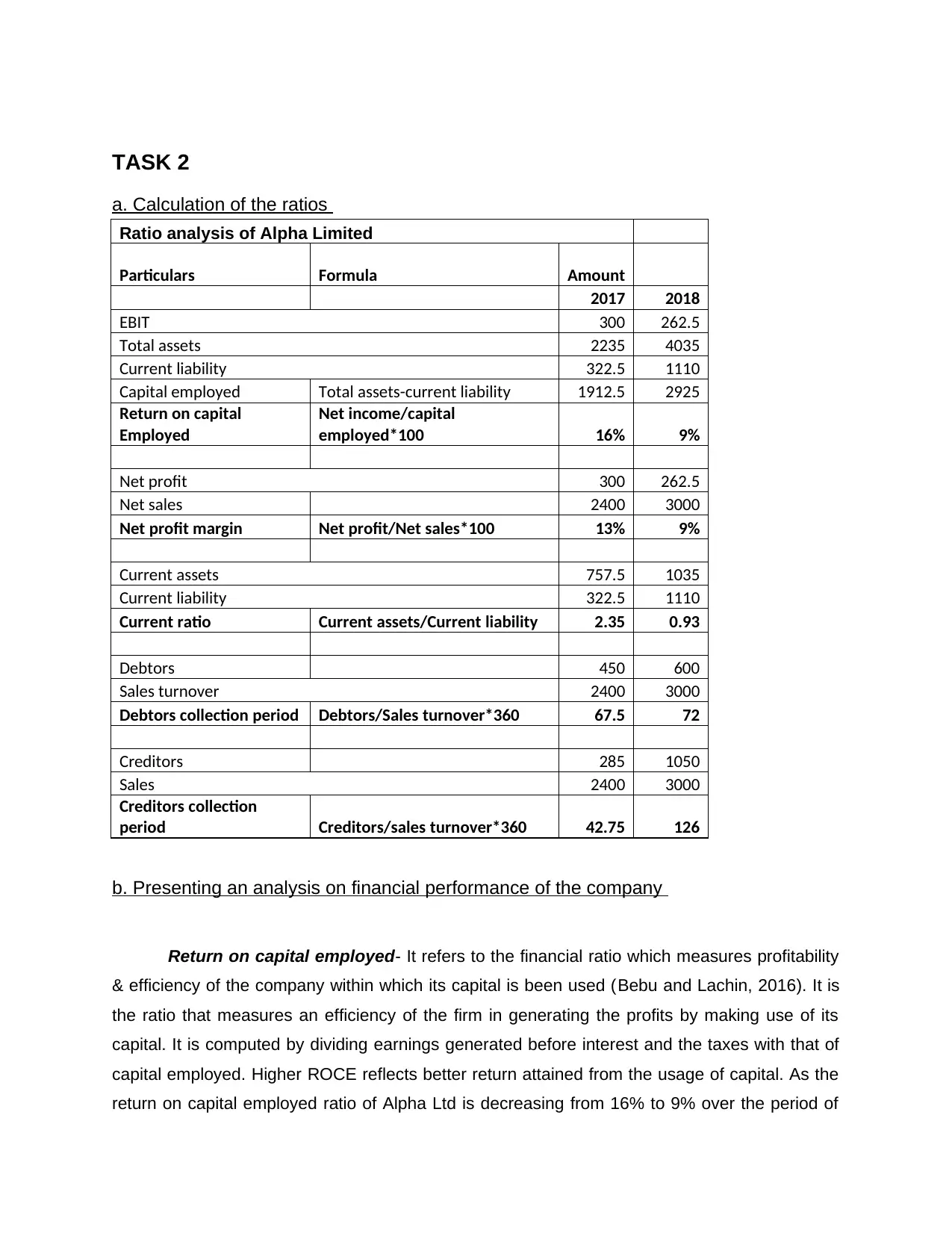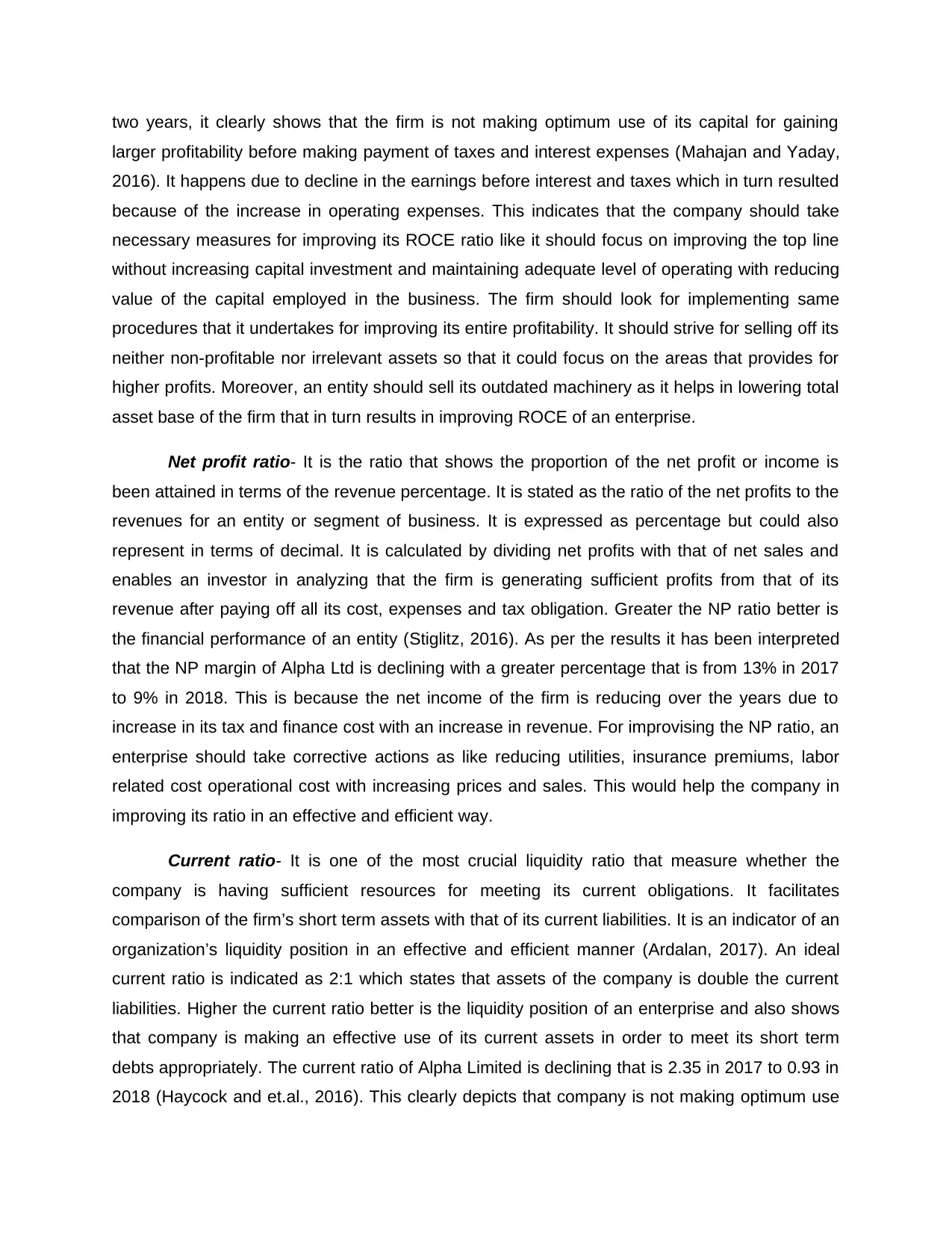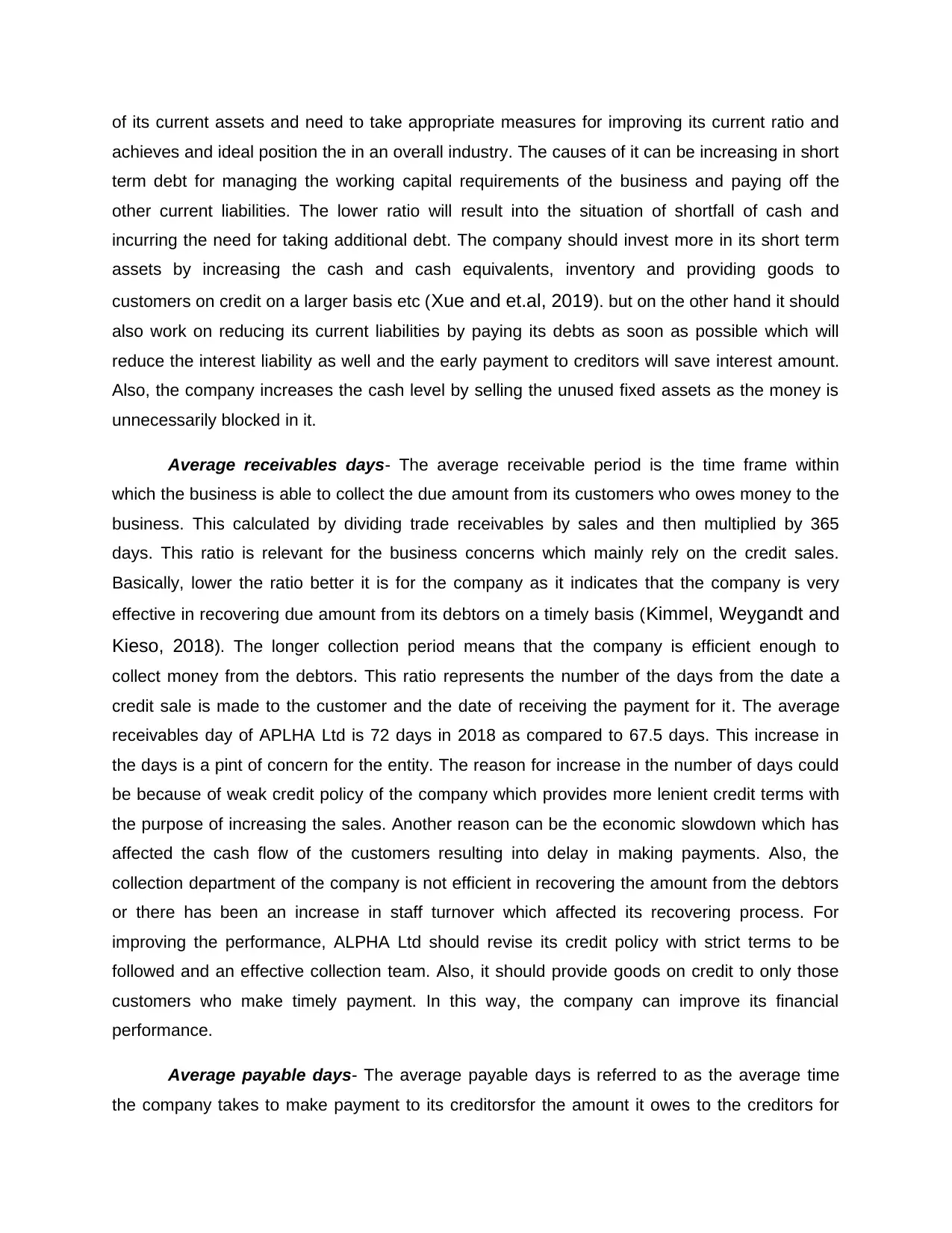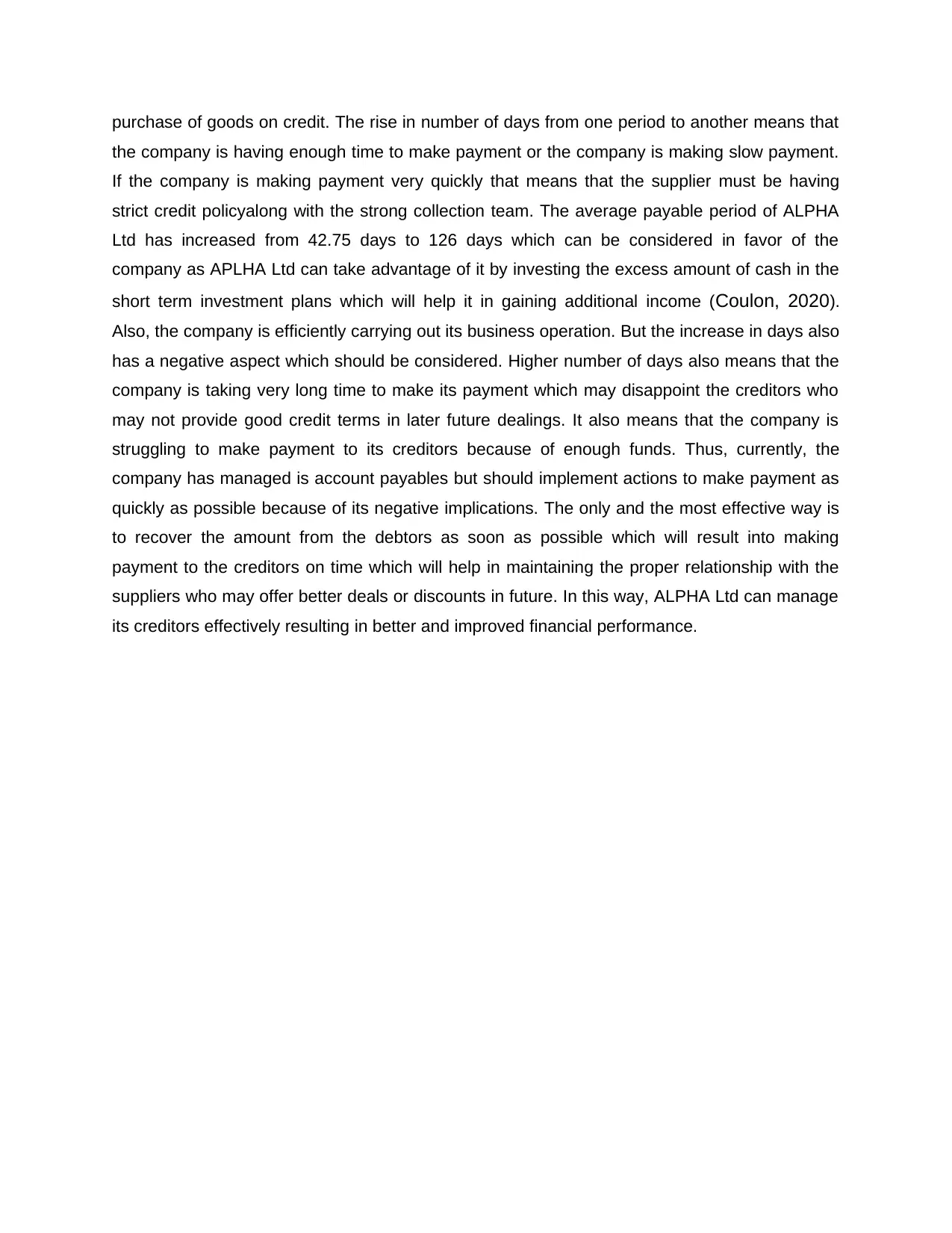Financial Decision Making
VerifiedAdded on 2023/01/11
|7
|1944
|22
AI Summary
This document provides an analysis of financial performance for Alpha Limited, including calculations of ratios such as return on capital employed, net profit margin, and current ratio. It discusses the implications of these ratios and suggests strategies for improvement. The document also includes references for further reading.
Contribute Materials
Your contribution can guide someone’s learning journey. Share your
documents today.

Financial Decision Making
Secure Best Marks with AI Grader
Need help grading? Try our AI Grader for instant feedback on your assignments.

TASK 2........................................................................................................................................ 3
a. Calculation of the ratios........................................................................................................3
b. Presenting an analysis on financial performance of the company........................................3
REFERENCES............................................................................................................................ 7
a. Calculation of the ratios........................................................................................................3
b. Presenting an analysis on financial performance of the company........................................3
REFERENCES............................................................................................................................ 7

TASK 2
a. Calculation of the ratios
Ratio analysis of Alpha Limited
Particulars Formula Amount
2017 2018
EBIT 300 262.5
Total assets 2235 4035
Current liability 322.5 1110
Capital employed Total assets-current liability 1912.5 2925
Return on capital
Employed
Net income/capital
employed*100 16% 9%
Net profit 300 262.5
Net sales 2400 3000
Net profit margin Net profit/Net sales*100 13% 9%
Current assets 757.5 1035
Current liability 322.5 1110
Current ratio Current assets/Current liability 2.35 0.93
Debtors 450 600
Sales turnover 2400 3000
Debtors collection period Debtors/Sales turnover*360 67.5 72
Creditors 285 1050
Sales 2400 3000
Creditors collection
period Creditors/sales turnover*360 42.75 126
b. Presenting an analysis on financial performance of the company
Return on capital employed- It refers to the financial ratio which measures profitability
& efficiency of the company within which its capital is been used (Bebu and Lachin, 2016). It is
the ratio that measures an efficiency of the firm in generating the profits by making use of its
capital. It is computed by dividing earnings generated before interest and the taxes with that of
capital employed. Higher ROCE reflects better return attained from the usage of capital. As the
return on capital employed ratio of Alpha Ltd is decreasing from 16% to 9% over the period of
a. Calculation of the ratios
Ratio analysis of Alpha Limited
Particulars Formula Amount
2017 2018
EBIT 300 262.5
Total assets 2235 4035
Current liability 322.5 1110
Capital employed Total assets-current liability 1912.5 2925
Return on capital
Employed
Net income/capital
employed*100 16% 9%
Net profit 300 262.5
Net sales 2400 3000
Net profit margin Net profit/Net sales*100 13% 9%
Current assets 757.5 1035
Current liability 322.5 1110
Current ratio Current assets/Current liability 2.35 0.93
Debtors 450 600
Sales turnover 2400 3000
Debtors collection period Debtors/Sales turnover*360 67.5 72
Creditors 285 1050
Sales 2400 3000
Creditors collection
period Creditors/sales turnover*360 42.75 126
b. Presenting an analysis on financial performance of the company
Return on capital employed- It refers to the financial ratio which measures profitability
& efficiency of the company within which its capital is been used (Bebu and Lachin, 2016). It is
the ratio that measures an efficiency of the firm in generating the profits by making use of its
capital. It is computed by dividing earnings generated before interest and the taxes with that of
capital employed. Higher ROCE reflects better return attained from the usage of capital. As the
return on capital employed ratio of Alpha Ltd is decreasing from 16% to 9% over the period of

two years, it clearly shows that the firm is not making optimum use of its capital for gaining
larger profitability before making payment of taxes and interest expenses (Mahajan and Yaday,
2016). It happens due to decline in the earnings before interest and taxes which in turn resulted
because of the increase in operating expenses. This indicates that the company should take
necessary measures for improving its ROCE ratio like it should focus on improving the top line
without increasing capital investment and maintaining adequate level of operating with reducing
value of the capital employed in the business. The firm should look for implementing same
procedures that it undertakes for improving its entire profitability. It should strive for selling off its
neither non-profitable nor irrelevant assets so that it could focus on the areas that provides for
higher profits. Moreover, an entity should sell its outdated machinery as it helps in lowering total
asset base of the firm that in turn results in improving ROCE of an enterprise.
Net profit ratio- It is the ratio that shows the proportion of the net profit or income is
been attained in terms of the revenue percentage. It is stated as the ratio of the net profits to the
revenues for an entity or segment of business. It is expressed as percentage but could also
represent in terms of decimal. It is calculated by dividing net profits with that of net sales and
enables an investor in analyzing that the firm is generating sufficient profits from that of its
revenue after paying off all its cost, expenses and tax obligation. Greater the NP ratio better is
the financial performance of an entity (Stiglitz, 2016). As per the results it has been interpreted
that the NP margin of Alpha Ltd is declining with a greater percentage that is from 13% in 2017
to 9% in 2018. This is because the net income of the firm is reducing over the years due to
increase in its tax and finance cost with an increase in revenue. For improvising the NP ratio, an
enterprise should take corrective actions as like reducing utilities, insurance premiums, labor
related cost operational cost with increasing prices and sales. This would help the company in
improving its ratio in an effective and efficient way.
Current ratio- It is one of the most crucial liquidity ratio that measure whether the
company is having sufficient resources for meeting its current obligations. It facilitates
comparison of the firm’s short term assets with that of its current liabilities. It is an indicator of an
organization’s liquidity position in an effective and efficient manner (Ardalan, 2017). An ideal
current ratio is indicated as 2:1 which states that assets of the company is double the current
liabilities. Higher the current ratio better is the liquidity position of an enterprise and also shows
that company is making an effective use of its current assets in order to meet its short term
debts appropriately. The current ratio of Alpha Limited is declining that is 2.35 in 2017 to 0.93 in
2018 (Haycock and et.al., 2016). This clearly depicts that company is not making optimum use
larger profitability before making payment of taxes and interest expenses (Mahajan and Yaday,
2016). It happens due to decline in the earnings before interest and taxes which in turn resulted
because of the increase in operating expenses. This indicates that the company should take
necessary measures for improving its ROCE ratio like it should focus on improving the top line
without increasing capital investment and maintaining adequate level of operating with reducing
value of the capital employed in the business. The firm should look for implementing same
procedures that it undertakes for improving its entire profitability. It should strive for selling off its
neither non-profitable nor irrelevant assets so that it could focus on the areas that provides for
higher profits. Moreover, an entity should sell its outdated machinery as it helps in lowering total
asset base of the firm that in turn results in improving ROCE of an enterprise.
Net profit ratio- It is the ratio that shows the proportion of the net profit or income is
been attained in terms of the revenue percentage. It is stated as the ratio of the net profits to the
revenues for an entity or segment of business. It is expressed as percentage but could also
represent in terms of decimal. It is calculated by dividing net profits with that of net sales and
enables an investor in analyzing that the firm is generating sufficient profits from that of its
revenue after paying off all its cost, expenses and tax obligation. Greater the NP ratio better is
the financial performance of an entity (Stiglitz, 2016). As per the results it has been interpreted
that the NP margin of Alpha Ltd is declining with a greater percentage that is from 13% in 2017
to 9% in 2018. This is because the net income of the firm is reducing over the years due to
increase in its tax and finance cost with an increase in revenue. For improvising the NP ratio, an
enterprise should take corrective actions as like reducing utilities, insurance premiums, labor
related cost operational cost with increasing prices and sales. This would help the company in
improving its ratio in an effective and efficient way.
Current ratio- It is one of the most crucial liquidity ratio that measure whether the
company is having sufficient resources for meeting its current obligations. It facilitates
comparison of the firm’s short term assets with that of its current liabilities. It is an indicator of an
organization’s liquidity position in an effective and efficient manner (Ardalan, 2017). An ideal
current ratio is indicated as 2:1 which states that assets of the company is double the current
liabilities. Higher the current ratio better is the liquidity position of an enterprise and also shows
that company is making an effective use of its current assets in order to meet its short term
debts appropriately. The current ratio of Alpha Limited is declining that is 2.35 in 2017 to 0.93 in
2018 (Haycock and et.al., 2016). This clearly depicts that company is not making optimum use
Secure Best Marks with AI Grader
Need help grading? Try our AI Grader for instant feedback on your assignments.

of its current assets and need to take appropriate measures for improving its current ratio and
achieves and ideal position the in an overall industry. The causes of it can be increasing in short
term debt for managing the working capital requirements of the business and paying off the
other current liabilities. The lower ratio will result into the situation of shortfall of cash and
incurring the need for taking additional debt. The company should invest more in its short term
assets by increasing the cash and cash equivalents, inventory and providing goods to
customers on credit on a larger basis etc (Xue and et.al, 2019). but on the other hand it should
also work on reducing its current liabilities by paying its debts as soon as possible which will
reduce the interest liability as well and the early payment to creditors will save interest amount.
Also, the company increases the cash level by selling the unused fixed assets as the money is
unnecessarily blocked in it.
Average receivables days- The average receivable period is the time frame within
which the business is able to collect the due amount from its customers who owes money to the
business. This calculated by dividing trade receivables by sales and then multiplied by 365
days. This ratio is relevant for the business concerns which mainly rely on the credit sales.
Basically, lower the ratio better it is for the company as it indicates that the company is very
effective in recovering due amount from its debtors on a timely basis (Kimmel, Weygandt and
Kieso, 2018). The longer collection period means that the company is efficient enough to
collect money from the debtors. This ratio represents the number of the days from the date a
credit sale is made to the customer and the date of receiving the payment for it. The average
receivables day of APLHA Ltd is 72 days in 2018 as compared to 67.5 days. This increase in
the days is a pint of concern for the entity. The reason for increase in the number of days could
be because of weak credit policy of the company which provides more lenient credit terms with
the purpose of increasing the sales. Another reason can be the economic slowdown which has
affected the cash flow of the customers resulting into delay in making payments. Also, the
collection department of the company is not efficient in recovering the amount from the debtors
or there has been an increase in staff turnover which affected its recovering process. For
improving the performance, ALPHA Ltd should revise its credit policy with strict terms to be
followed and an effective collection team. Also, it should provide goods on credit to only those
customers who make timely payment. In this way, the company can improve its financial
performance.
Average payable days- The average payable days is referred to as the average time
the company takes to make payment to its creditorsfor the amount it owes to the creditors for
achieves and ideal position the in an overall industry. The causes of it can be increasing in short
term debt for managing the working capital requirements of the business and paying off the
other current liabilities. The lower ratio will result into the situation of shortfall of cash and
incurring the need for taking additional debt. The company should invest more in its short term
assets by increasing the cash and cash equivalents, inventory and providing goods to
customers on credit on a larger basis etc (Xue and et.al, 2019). but on the other hand it should
also work on reducing its current liabilities by paying its debts as soon as possible which will
reduce the interest liability as well and the early payment to creditors will save interest amount.
Also, the company increases the cash level by selling the unused fixed assets as the money is
unnecessarily blocked in it.
Average receivables days- The average receivable period is the time frame within
which the business is able to collect the due amount from its customers who owes money to the
business. This calculated by dividing trade receivables by sales and then multiplied by 365
days. This ratio is relevant for the business concerns which mainly rely on the credit sales.
Basically, lower the ratio better it is for the company as it indicates that the company is very
effective in recovering due amount from its debtors on a timely basis (Kimmel, Weygandt and
Kieso, 2018). The longer collection period means that the company is efficient enough to
collect money from the debtors. This ratio represents the number of the days from the date a
credit sale is made to the customer and the date of receiving the payment for it. The average
receivables day of APLHA Ltd is 72 days in 2018 as compared to 67.5 days. This increase in
the days is a pint of concern for the entity. The reason for increase in the number of days could
be because of weak credit policy of the company which provides more lenient credit terms with
the purpose of increasing the sales. Another reason can be the economic slowdown which has
affected the cash flow of the customers resulting into delay in making payments. Also, the
collection department of the company is not efficient in recovering the amount from the debtors
or there has been an increase in staff turnover which affected its recovering process. For
improving the performance, ALPHA Ltd should revise its credit policy with strict terms to be
followed and an effective collection team. Also, it should provide goods on credit to only those
customers who make timely payment. In this way, the company can improve its financial
performance.
Average payable days- The average payable days is referred to as the average time
the company takes to make payment to its creditorsfor the amount it owes to the creditors for

purchase of goods on credit. The rise in number of days from one period to another means that
the company is having enough time to make payment or the company is making slow payment.
If the company is making payment very quickly that means that the supplier must be having
strict credit policyalong with the strong collection team. The average payable period of ALPHA
Ltd has increased from 42.75 days to 126 days which can be considered in favor of the
company as APLHA Ltd can take advantage of it by investing the excess amount of cash in the
short term investment plans which will help it in gaining additional income (Coulon, 2020).
Also, the company is efficiently carrying out its business operation. But the increase in days also
has a negative aspect which should be considered. Higher number of days also means that the
company is taking very long time to make its payment which may disappoint the creditors who
may not provide good credit terms in later future dealings. It also means that the company is
struggling to make payment to its creditors because of enough funds. Thus, currently, the
company has managed is account payables but should implement actions to make payment as
quickly as possible because of its negative implications. The only and the most effective way is
to recover the amount from the debtors as soon as possible which will result into making
payment to the creditors on time which will help in maintaining the proper relationship with the
suppliers who may offer better deals or discounts in future. In this way, ALPHA Ltd can manage
its creditors effectively resulting in better and improved financial performance.
the company is having enough time to make payment or the company is making slow payment.
If the company is making payment very quickly that means that the supplier must be having
strict credit policyalong with the strong collection team. The average payable period of ALPHA
Ltd has increased from 42.75 days to 126 days which can be considered in favor of the
company as APLHA Ltd can take advantage of it by investing the excess amount of cash in the
short term investment plans which will help it in gaining additional income (Coulon, 2020).
Also, the company is efficiently carrying out its business operation. But the increase in days also
has a negative aspect which should be considered. Higher number of days also means that the
company is taking very long time to make its payment which may disappoint the creditors who
may not provide good credit terms in later future dealings. It also means that the company is
struggling to make payment to its creditors because of enough funds. Thus, currently, the
company has managed is account payables but should implement actions to make payment as
quickly as possible because of its negative implications. The only and the most effective way is
to recover the amount from the debtors as soon as possible which will result into making
payment to the creditors on time which will help in maintaining the proper relationship with the
suppliers who may offer better deals or discounts in future. In this way, ALPHA Ltd can manage
its creditors effectively resulting in better and improved financial performance.

REFERENCES
Books and journal
Ardalan, K., 2017. Advancing the Interpretation of the Du Pont Equation. Journal of Modern
Accounting and Auditing. 13(7). pp.294-298.
Bebu, I. and Lachin, J. M., 2016. Large sample inference for a win ratio analysis of a composite
outcome based on prioritized components. Biostatistics. 17(1). pp.178-187.
Coulon, Y., 2020. Efficiency Ratios. In Rational Investing with Ratios (pp. 31-45).
Palgrave Pivot, Cham.
Haycock, P.C. and et.al., 2016. Best (but oft-forgotten) practices: the design, analysis, and
interpretation of Mendelian randomization studies. The American journal of clinical
nutrition. 103(4). pp.965-978.
Kimmel, P.D., Weygandt, J.J. and Kieso, D.E., 2018. Financial accounting: tools for
business decision making. John Wiley & Sons.
Mahajan, N. and Yaday, A., 2016. A financial statement analysis-case study for an
industry. International Journal of Engineering and Technical Research. 5(3). pp.6-8.
Stiglitz, J. E., 2016. New theoretical perspectives on the distribution of income and wealth
among individuals. In Inequality and Growth: Patterns and Policy (pp. 1-71). Palgrave
Macmillan, London.
Xue, R. and et.al, 2019, April. Financial Literacy and Financial Decision-making: The
mediating role of financial concerns. In The 10th Financial Markets & Corporate
Governance Conference: Capital Markets, Sustainability and Disruptive
Technologies.
Books and journal
Ardalan, K., 2017. Advancing the Interpretation of the Du Pont Equation. Journal of Modern
Accounting and Auditing. 13(7). pp.294-298.
Bebu, I. and Lachin, J. M., 2016. Large sample inference for a win ratio analysis of a composite
outcome based on prioritized components. Biostatistics. 17(1). pp.178-187.
Coulon, Y., 2020. Efficiency Ratios. In Rational Investing with Ratios (pp. 31-45).
Palgrave Pivot, Cham.
Haycock, P.C. and et.al., 2016. Best (but oft-forgotten) practices: the design, analysis, and
interpretation of Mendelian randomization studies. The American journal of clinical
nutrition. 103(4). pp.965-978.
Kimmel, P.D., Weygandt, J.J. and Kieso, D.E., 2018. Financial accounting: tools for
business decision making. John Wiley & Sons.
Mahajan, N. and Yaday, A., 2016. A financial statement analysis-case study for an
industry. International Journal of Engineering and Technical Research. 5(3). pp.6-8.
Stiglitz, J. E., 2016. New theoretical perspectives on the distribution of income and wealth
among individuals. In Inequality and Growth: Patterns and Policy (pp. 1-71). Palgrave
Macmillan, London.
Xue, R. and et.al, 2019, April. Financial Literacy and Financial Decision-making: The
mediating role of financial concerns. In The 10th Financial Markets & Corporate
Governance Conference: Capital Markets, Sustainability and Disruptive
Technologies.
1 out of 7
Related Documents
Your All-in-One AI-Powered Toolkit for Academic Success.
+13062052269
info@desklib.com
Available 24*7 on WhatsApp / Email
![[object Object]](/_next/static/media/star-bottom.7253800d.svg)
Unlock your academic potential
© 2024 | Zucol Services PVT LTD | All rights reserved.




